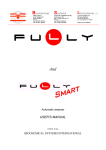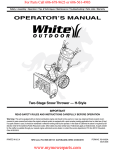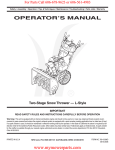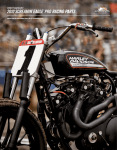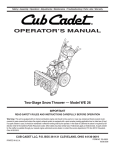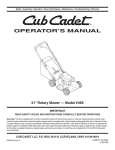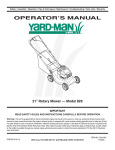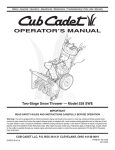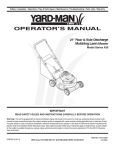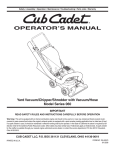Download White Outdoor OGST-3106 Operator`s manual
Transcript
Operator’s Manual Two Stage Snow Thrower IMPORTANT: Read safety rules and instructions carefully before operating equipment. 60 OTTAWA STREET SOUTH, KITCHENER, ONTARIO N2G 3S7 PRINTED IN U.S.A. OGST-3106A (5/2005) TABLE OF CONTENTS Content Customer Support Important Safe Operation Practices Assembly Knowing Your Snow Thrower Operatiing Your Snow Thrower Page 2 3 5 8 10 Content Ajustments Maintenance Servicing Off-Season Storage Warranty Illustrated Parts List Page 12 13 15 18 19 20 FINDING MODEL NUMBER This Operator’s Manual is an important part of your new snow thrower. It will help you to assemble, prepare and maintain the unit for best performance. Please read and understand what it says. Before you start assembling your new snow thrower, please locate the model plate on the equipment and copy the information from it in the space provided below. The information on the model plate is very important if you need help from our Customer Support Department or an authorized dealer. • You can locate the model number by standing behind the unit in the operating position and looking down at the dash panel . A sample model plate is explained below. For future reference, please copy the model number and the serial number of the equipment in the space below. Model Number Numéro de modèle Serial Number Numéro de série XXXXXXXXXX XXXXXXXXXXX Copy the model number here: WHITE OUTDOOR CANADA KITCHENER, ON N2G 4J1 Copy the serial number here: ENGINE INFORMATION The engine manufacturer is responsible for all engine-related issues with regards to performance, power-rating, specifications, warranty and service. Please refer to the engine manufacturer’s Owner’s/Operator’s Manual packed separately with your unit for more information. 2 SECTION 1: IMPORTANT SAFE OPERATION PRACTICES WARNING: This symbol points out important safety instructions which, if not followed, could endanger the personal safety and/or property of yourself and others. Read and follow all instructions in this manual before attempting to operate this machine. Failure to comply with these instructions may result in personal injury. When you see this symbol—heed its warning. DANGER: This machine was built to be operated according to the rules for safe operation in this manual. As with any type of power equipment, carelessness or error on the part of the operator can result in serious injury. This machine is capable of amputating hands and feet and throwing objects. Failure to observe the following safety instructions could result in serious injury or death. Training 1. 2. 3. 4. 5. 6. 7. 8. Read, understand, and follow all instructions on the machine and in the manual(s) before attempting to assemble and operate. Keep this manual in a safe place for future and regular reference and for ordering replacement parts. Be familiar with all controls and their proper operation. Know how to stop the machine and disengage them quickly. Never allow children under 14 years old to operate this machine. Children 14 years old and over should read and understand the operation instructions and safety rules in this manual and should be trained and supervised by a parent. Never allow adults to operate this machine without proper instruction. Thrown objects can cause serious personal injury. Plan your snow throwing pattern to avoid discharge of material toward roads, bystanders and the like. Keep bystanders, helpers, pets and children at least 75 feet from the machine while it is in operation. Stop machine if anyone enters the area. Exercise caution to avoid slipping or falling, especially when operating in reverse. 9. Preparation 1. 2. 3. 4. 5. 6. 7. Thoroughly inspect the area where the equipment is to be used. Remove all door mats, newspapers, sleds, boards, wires and other foreign objects which could be tripped over or thrown by the auger/impeller. Always wear safety glasses or eye shields during operation and while performing an adjustment or repair to protect your eyes. Thrown objects which ricochet can cause serious injury to the eyes. Do not operate without wearing adequate winter outer garments. Do not wear jewelry, long scarves or other loose clothing which could become entangled in moving parts. Wear footwear which will improve footing on slippery surfaces. Use a grounded extension cord and receptacle for all units with electric start engines. Adjust collector housing height to clear gravel or crushed rock surfaces. Disengage the control handle before starting the engine. Never attempt to make any adjustments while engine is running, except where specifically recommended in the operator’s manual. Let engine and machine adjust to outdoor temperature before starting to clear snow. To avoid personal injury or property damage use extreme care in handling gasoline. Gasoline is extremely flammable and the vapors are explosive. Serious personal injury can occur when gasoline is spilled on yourself or your clothes which can ignite. Wash your skin and change clothes immediately. a. Use only an approved gasoline container. b. Extinguish all cigarettes, cigars, pipes and other sources of ignition. c. Never fuel machine indoors. d. Never remove gas cap or add fuel while the engine is hot or running. e. Allow engine to cool at least two minutes before refueling. f. Never over fill fuel tank. Fill tank to no more than ½ inch below bottom of filler neck to provide space for fuel expansion. g. Replace gasoline cap and tighten securely. h. If gasoline is spilled, wipe it off the engine and equipment. Move machine to another area. Wait 5 minutes before starting the engine. i. Never store the machine or fuel container inside where there is an open flame, spark or pilot light (e.g. furnace, water heater, space heater, clothes dryer etc.). j. Allow machine to cool at least 5 minutes before storing. Operation 1. 2. 3. 4. 5. 3 Do not put hands or feet near rotating parts, in the auger housing or discharge chute. Contact with the rotating parts can amputate hands and feet. The auger control handle is a safety device. Never bypass its operation. Doing so, makes the machine unsafe and may cause personal injury. The control handle must operate easily in both directions and automatically return to the disengaged position when released. Never operate with a missing or damaged discharge chute. Keep all safety devices in place and working. Never run an engine indoors or in a poorly ventilated area. Engine exhaust contains carbon monoxide, an odorless and deadly gas. 6. 7. 8. 9. 10. 11. 12. 13. 14. 15. 16. 17. 18. 19. 20. Maintenance And Storage Do not operate machine while under the influence of alcohol or drugs. Muffler and engine become hot and can cause a burn. Do not touch. Exercise extreme caution when operating on or crossing gravel surfaces. Stay alert for hidden hazards or traffic. Exercise caution when changing direction and while operating on slopes. Plan your snow throwing pattern to avoid discharge towards windows, walls, cars etc. To avoid property damage or personal injury caused by a ricochet. Never direct discharge at children, bystanders and pets or allow anyone in front of the machine. Do not overload machine capacity by attempting to clear snow at too fast of a rate. Never operate this machine without good visibility or light. Always be sure of your footing and keep a firm hold on the handles. Disengage power to the auger/impeller when transporting or not in use. Never operate machine at high transport speeds on slippery surfaces. Look down and behind and use care when in reverse. If the machine should start to vibrate abnormally, stop the engine, disconnect the spark plug and ground it against the engine. Inspect thoroughly for damage. Repair any damage before starting and operating. Disengage the control handle and stop engine before you leave the operating position (behind the handles). Wait until the auger comes to a complete stop before unclogging the discharge chute, making any adjustments, or inspections. Never put your hand in the discharge or collector openings. Always use a clearing tool to unclog the discharge opening. Use only attachments and accessories approved by the manufacturer. If situations occur which are not covered in this manual, use care and good judgment. Call customer assistance for the name of your nearest servicing dealer. 1. Never tamper with safety devices. Check their proper operation regularly. 2. Disengage the control handle and stop engine. Wait until the auger/impeller come to a complete stop. Disconnect the spark plug wire and ground against the engine to prevent unintended starting before cleaning, repairing, or inspecting. 3. Check bolts, and screws for proper tightness at frequent intervals to keep the machine in safe working condition. Also, visually inspect machine for any damage. 4. Do not change the engine governor setting or over-speed the engine. The governor controls the maximum safe operating speed of the engine. 5. Snow thrower shave plates and skid shoes are subject to wear and damage. For your safety protection, frequently check all components and replace with original equipment manufacturer’s (O.E.M.) parts only. “Use of parts which do not meet the original equipment specifications may lead to improper performance and compromise safety!” 6. Check controls periodically to verify they engage and disengage properly and adjust, if necessary. Refer to the adjustment section in this operator’s manual for instructions. 7. Maintain or replace safety and instruction labels, as necessary. 8. Observe proper disposal laws and regulations for gas, oil, etc. to protect the environment. 9. Prior to storing, run machine a few minutes to clear snow from machine and prevent freeze up of auger/impeller. 10. Never store the machine or fuel container inside where there is an open flame, spark or pilot light such as a water heater, furnace, clothes dryer etc. 11. Always refer to the operator’s manual for proper instructions on off-season storage. Your Responsibility: • Restrict the use of this power machine to persons who read, understand and follow the warnings and instructions in this manual and on the machine. DANGER DANGER NEVER PUT HAND IN CHUTE. CAN AMPUTATE HANDS AND FINGERS. STOP ENGINE AND AUGER BEFORE USING CLEAN-OUT TOOL OR STICK. NE PLACEZ JAMAIS VOS MAINS DANS LA GOULOTTE. LES PIÈCES EN MOUVEMENT PEUVENT AMPUTER MAINS ET DOIGTS. ARRÊTEZ LE MOTEUR ET LA TARIÈRE AVANT D'UTILISER L'OUTIL DE DÉGAGEMENT DE LA GOULOTTE OU UN BÂTON. 4 SECTION 2: ASSEMBLING YOUR SNOW THROWER NOTE: This Operator’s Manual covers several models. Snow thrower features vary by model. Not all features discussed in this manual are applicable to all snow thrower models. Assembling Handle Loose Parts • • • • The augers are secured to the auger shaft with shear pins and bow tie cotter pins. If you hit a foreign object or ice jam, the snow thrower is designed so that the pins may shear. Two replacement shear pins and cotter pins are provided for your convenience. See Figure 1. Store these safely until needed. Remove the lower plastic wing nut, cupped washer and carriage bolt from each side of the lower handle. See Figure 2. Raise the upper handle assembly until it locks over the lower handle. Look at the lower rear of the snow thrower frame to be sure all the cables are aligned with the cable roller guides. Make sure the spring (found at the end of each cable) is attached to its actuator bracket. Upper Handle Cotter Pins Steering Cable Shear Pins Tighten these Wing Nuts Figure 1 IMPORTANT: NEVER replace the auger shear pins with Lower Handle standard hex bolts. Any damage to the auger gearbox or other components from using standard bolts will not be covered by your snow thrower’s warranty. Cable Tie Upper Shift Rod Shift Rod Connector Items Required For Assembly 1. Pair of pliers 2. Engine oil 3. Fresh gasoline Cupped Washer Before Assembly Wing Nut WARNING: Disconnect the spark plug wire Carriage Bolt Lower Shift Rod and ground it against the engine to prevent unintended starting. NOTE: Support Tubes are omitted from the illustration for clarity. NOTE: Reference to the right hand or left hand side of machine are observed from the operating position. Figure 2 • • • Secure the upper handle and lower handle with the two plastic wing nuts, cupped washers and carriage bolts previously removed. Tighten the two wing nuts already in place on the upper holes and secure the handles firmly. Slide the shift rod connector down over the end of the lower shift rod. Tap the connector until it locks over the lower shift rod. See Figure 2. NOTE: If the connector is not properly assembled, the shift rod will pivot and you will not be able to change speeds or direction. 5 Attaching the Chute Assembly • NOTE: Your chute assembly may or may not be assembled. If it requires assembly use the following instructions. With the hex nuts loosened on the lower chute crank bracket (see Figure 5) adjust the bracket so that the spiral on the chute crank fully engages the teeth on the chute assembly. Tighten the nuts on the lower chute crank bracket securely. Chute Directional Control Chute Assembly Hex Screw Chute Assembly Lower Chute Bracklet Hex Lock Nut Chute Flange Keeper Lock Nuts Figure 5 Figure 3 • • • Place chute assembly over chute opening, with the opening in the chute assembly facing the front of the unit. Place chute flange keepers beneath lip of chute assembly, with the flat side of chute flange keeper facing downward. Insert hex cap screws up through chute flange keeper and chute assembly as shown in Figure 3. Secure with hex flange locknuts. Tighten with two 7/16” wrenches. Do not over tighten. • The cable ties normally are loosely installed on each side of the lower handle at the factory. Pull the cable ties tight to secure. Trim excess from the ends of cable ties. If not already attached, slip the cables that run from the handle panel to the discharge chute into the cable guide located on top of the engine. See Figure 6. Cables Cable Guide Attaching Chute Crank • Remove the hairpin clip from the upper chute crank and slide the upper chute crank through the upper chute crank bracket and into the lower chute crank. A pair of pliers may help in this job. Discharge Chute Upper Chute Crank Figure 6 • Wrap the wire from the head lamp down the right handle until the wire can be plugged into the alternator lead wire under the fuel tank. Upper Chute Crank Bracket Alternator Lead Hairpin Clip Alternator Lead Lower Chute Crank Figure 4 • Lamp Wire Align the two holes on both chute cranks and secure with the hairpin clip removed earlier. See Figure 4. NOTE: Wheels are omitted from illustration for clarity. Figure 7 6 Chute Clean-Out Tool • WARNING: Do not over-tighten the cable. Over-tightening may prevent the auger from disengaging and compromise the safety of the snow thrower. The chute clean-out tool is conveniently fastened to the rear of the auger housing with a mounting clip. Use the clean-out tool to clear snow and ice which may lodge in the discharge chute during operation. Refer to the Operation section for more detailed information regarding the chute clean-out tool. • Final Adjustments • Make these final adjustments before operating your snow thrower for the first time. Failure to follow these instructions may cause damage to the snow thrower. • Wheel Drive Control & Shift Lever • Perform the following test to determine need for adjustment: • • Move the shift lever into sixth (6) position. See Figure 11. • With the drive control released, push the snow thrower forward, then pull it back. The machine should move freely. • Engage the drive control and attempt to move the machine both forward and back, resistance should be felt. • Move the shift lever into the fast reverse (R2) position and repeat the previous two steps. If you experienced resistance rolling the unit, either when repositioning the shift lever from 6 to R2 or when attempting to move the machine with the drive control released, adjust the drive control immediately. To adjust, proceed as follows: • • • In a well-ventilated area, start the snow thrower engine as instructed on page 10. Make sure the throttle is set in the fast position. While standing in the operator’s position (behind the snow thrower) engage the auger. Allow the auger to remain engaged for approximately ten seconds before releasing the auger control. Repeat this several times. With the engine running in the fast position and the auger control lever in the disengaged “up” position, walk to the front of the machine. Confirm that the auger has completely stopped rotating and shows no signs of motion. IMPORTANT: If the auger shows any signs of rotating, immediately return to the operator’s position and shut off the engine. Wait for all moving parts to stop before readjusting the auger control cable. • • • • Loosen the jam nut on the traction control cable and unthread the cable one full turn. Recheck adjustment. Retighten the jam nut to secure the cable when correct adjustment is reached. To readjust the control cable, unhook the spring (found on the end of the auger cable) from the auger actuator bracket. See Figure 9. Push the cable coupler through the end of the spring to expose the lock nut. See Figure 10. Thread the lock nut outward (down the coupler) three full turns to provide more slack in the cable and reattach the spring to the bracket. Repeat auger control test to verify for proper adjustment. Repeat previous steps to adjust more, if necessary. NOTE: For more details, refer to Wheel Drive Control Adjustment in the Adjustment Section of this manual. Drive Spring Auger Control Check the adjustment of the auger control as follows: • When the auger control is released and in the disengaged “up” position, the cable should have very little slack, but should NOT be tight. See Figure 8. Released/Disengaged Position Drive Actuator Bracket Auger Spring Auger Actuator Bracket Figure 9 Figure 8 7 Tire Pressure (Pneumatic Tires) The tires are overinflated for shipping purposes. Coupler Spring k lac sS Les Cable • k lac re S Mo Check tire pressure. Maintain pressure between 10 and 14 psi. NOTE: If the tire pressure is not equal in all tires, the unit may pull to one side or the other. WARNING: Maximum tire pressure under any circumstance is 30 psi. Equal tire pressure should be maintained at all times. Excessive pressure (over 30 psi) when seating beads may cause tire/rim assembly to burst with force sufficient to cause serious injury. Lock Nut Figure 10 SECTION 3: KNOWING YOUR SNOW THROWER WARNING: Be familiar with all the controls on the snow thrower and their proper operation. Know how to stop the machine and disengage them quickly. • Compare the Figure below with your equipment and be familiar with its controls before starting it. Headlight Wheel DriveControl / Auger Control Lock Fuel Tank Shift Lever Chute Tilt Control Auger Drive Control Oil Fill Discharge Chute Chute Crank Chute Clean-Out Tool Wheel Steering Control Auger Skid Shoe Figure 11 Drive Control / Auger Control Lock simultaneously with the drive control, the operator can release the auger control (on the left handle) and the augers will remain engaged. Release the drive control to stop the augers and wheel drive (the auger control must also be released). The drive control is located on the right handle. Squeeze the drive control to engage the wheel drive. Release to stop. This same lever also locks the auger control so you can operate the chute crank without interrupting the snow throwing process. If the auger control is engaged IMPORTANT: Always release the drive control before changing speeds. 8 Auger Control Chute Tilt Control The auger control is located on the left handle. Squeeze the auger control to engage the augers. Release to stop the snow throwing action. The drive control must also be released in order to stop auger. The distance snow is thrown can be changed by adjusting the angle of the chute assembly. Move the chute tilt control forward to decrease the distance, toward the rear to increase. Wheel Steering Controls Shift Lever The shift lever is located in the center of the handle panel and is used to determine ground speed and direction of travel. It can be moved into any of eight positions. IMPORTANT: Always release drive control before changing speeds. Forward: The snow thrower has six forward (F) speeds. Position one (1) is the slowest and position six (6) is the fastest. 4 The left and right wheel steering controls are located on the underside of the handles. 3 • 6 5 F 2 1 Squeeze the right control to turn right; squeeze the left control to turn left. NOTE: Operate the snow thrower in open areas until you are familiar with these controls. Skid Shoe R R1 The skid shoe position is determined by the condition of the ground from where snow has to be removed. Higher the snow level, lower will be the skid shoe. Adjust it accordingly. R2 Reverse: The snow thrower has two reverse (R) speeds—R1 is the slower of the two. Headlight The headlight is on whenever the engine is running. Discharge Chute Throttle Control The angle of the discharge chute controls the distance that the snow is thrown. Tilt the discharge chute up for greater distance; tilt down for less distance. The throttle control is located on the engine. It regulates the speed of the engine. Chute Crank Safety Ignition Key The chute crank is located on the left side of the snow thrower. Use it to change the direction in which snow is thrown. Avoid targetting persons, animals or cars and buildings. The safety ignition key must be fully inserted in the switch before the unit will start. Remove key when snow thrower is not in use. Do not attempt to turn the key. CLOCKWISE TO DISCHARGE LEFT COUNTER CLOCKWISE TO DISCHARGE RIGHT Chute Clean-Out Tool The chute clean-out tool is designed to clear a clogged discharge chute. Refer to page 11 for instructions on it. WARNING: Never use your hand to clear a clogged discharge chute. Shut off engine and remain behind handles until all moving parts have stopped before unclogging. 9 SECTION 4: OPERATING YOUR SNOW THROWER Before Starting Read and understand all instructions and warnings on the machine and in this manual before operating. • Gas & Oil Fill-Up • • • Service the engine with gasoline and oil as instructed in the separate engine manual shipped with the snow thrower. WARNING: Use extreme care when handling gasoline. Gasoline is extremely flammable and the vapors are explosive. Never fuel machine indoors or while the engine is hot or running. Extinguish cigarettes, cigars, pipes an other sources of ignition. • • To Start Engine NOTE: If unit shows any sign of motion (drive or augers) with the clutch grips disengaged, shut engine off immediately. Readjust as instructed in the Final Adjustments in the Assembly Section. • • • • • Recoil Starter Attach spark plug wire to spark plug. Make certain the auger and drive clutch levers are in the disengaged (released) position. See Figure 6. Move throttle control up to FAST position. Insert ignition key into slot. Be certain it snaps into place. Do not turn key. • • NOTE: Engine will not start unless ignition key is inserted into ignition slot in carburetor cover. • Electric Starter (optional) • WARNING: The electric starter is equipped with a grounded three-wire power cord and plug and is designed to operate on 120 volt AC household current. It must be used with a properly grounded three-prong receptacle at all times to avoid the possibility of electric shock. Follow all instructions carefully prior to operating the electric starter. • using the electric starter. If you have a grounded three-prong receptacle, proceed as follows: Connect power cord to switch box on engine. Plug the other end of power cord into a three-hole, grounded 120 volt AC receptacle. Rotate choke knob to ON position. Push primer button three times, as instructed in the engine manual, making sure to cover vent hole when pushing. Push starter button on top of the Primer engine to crank engine. As you Vent Hole crank the engine, move choke knob to FULL choke position. When engine starts, release starter button, and move choke gradually to OFF. If engine falters, move choke immediately to FULL and then gradually to OFF. When disconnecting the power cord, always unplug from the three-prong receptacle first and then from the snow thrower. • Rotate choke knob to FULL choke position (cold engine start). If engine is warm, place choke in OFF position instead of FULL. Push primer button two or three times. If engine is warm, push primer button once only. Always cover vent hole in primer button when pushing. At temperatures below 15°F, additional priming may be necessary . Grasp starter handle and pull rope out slowly, until it pulls slightly harder. Let rope rewind slowly. Pull starter handle rapidly. Do not allow handle to snap back. Allow it to rewind slowly while keeping a firm hold on the starter handle. Repeat the previous steps until engine starts. To Stop Engine • • Determine that your house wiring is a three-wire grounded system. Ask a licensed electrician if you are not certain. If your house wiring system is not a three-wire grounded system, do not use this electric starter under any conditions. If your home electrical system is grounded, but a three-hole receptacle is not available, one should be installed by a licensed electrician before 10 Run engine for a few minutes before stopping to help dry off any moisture on the engine. To prevent possible freeze-up of starter: Electric Starter: Connect power cord to switch box on engine, then to 120 volt AC receptacle. With the engine running, push starter button and spin the starter for several seconds. The unusual sound made by spinning the starter will not harm engine or starter. Disconnect the power cord from receptacle first, and then from switch box. Recoil Starter: With engine running, pull starter rope with a rapid, continuous full arm stroke three or four times. Pulling the starter rope will produce a • • • • • • loud clattering sound, which is not harmful to the engine or starter. Move throttle control to “stop” or “off” position. Remove ignition key. Do not turn key. Disconnect the spark plug wire from the spark plug to prevent accidental starting while equipment is unattended. NOTE: Keep key in a safe place. Engine will not start without ignition key. • Chute Clean-Out Tool Wipe all snow and moisture from the carburetor cover in the area of the control levers. Also, move control levers back and forth several times. The chute clean-out tool is conveniently fastened to the rear of the auger housing with a mounting clip. Never use your hand to clean a clogged chute or chute opening; use this clean-out tool instead. To Engage Wheel Drive • • With the engine running near top speed, move shift lever to one of the eight positions to set desired speed and direction. Select speed appropriate for the snow conditions that exist. • • NOTE: Use slower speeds in higher snow and/or until you are familiar with the snow thrower operation. • • • Squeeze wheel drive control against the right handle to move the snow thrower; release it to stop. • IMPORTANT: NEVER move the shift lever without first releasing the wheel drive control. Doing so will cause premature wear on the drive system’s friction wheel. To Engage Augers • • If possible, remove snow immediately after it falls. Discharge snow downwind whenever possible. Slightly overlap each previous path. Set the skid shoes 1/4" below the shave plate for normal usage. Adjust it upward for hard-packed snow and downward when using on gravel or crushed rock. Release both the wheel drive control and the auger drive control levers. Stop the engine by removing the ignition key. Remove the chute clean-out tool from the clip which secures it to the rear of the auger housing. See Figure 12. Use the shovel-shaped end of the clean-out tool to remove any snow and ice in the discharge chute. Re-fasten the clean-out tool to the mounting clip on the rear of the auger housing and restart engine. While standing in the operator’s position (behind the snow thrower), engage the auger clutch lever for a few seconds to clear any remaining snow or ice from the discharge chute before continuing to clear snow. Chute Clean-Out Tool To engage augers and start snow throwing, squeeze the auger control against the left handle. To disengage power to the augers, release both the auger control and the wheel drive control, if engaged. Clip Operating Tips NOTE: Allow the engine to warm up for a few minutes. The engine will not develop full power until it reaches operating temperature. WARNING: The temperature of the muffler and the surrounding areas may exceed 150°F (65°C ). Avoid these areas. Figure 12 11 SECTION 5: MAKING ADJUSTMENTS • WARNING: NEVER attempt to clean chute • or make any adjustments while engine is running. • Shift Rod • • • • • Remove the hairpin clip and flat washer from the shift handle under the handle panel. See Figure 13. Place shift lever in sixth (6) position or fastest forward speed. Push shift arm assembly down as far as it will go. Rotate the ferrule up or down on the shift rod as necessary until the ferrule lines up with the hole shown in Figure 13. Insert ferrule and reinstall the washer and hairpin clip. • • • • • IMPORTANT: Before operating the snow thrower, make sure the shift rod is adjusted according to instructions on page 7. Tip the snow thrower forward, allowing it to rest on the auger housing. Remove the frame cover underneath the snow thrower by removing six self-tapping screws. With the wheel drive control released, check if there is clearance between friction wheel and drive plate in all positions of the shift lever. See Figure 14. With the traction control lever engaged, check if the friction wheel solidly contacts the drive plate. See Figure 14. If not, adjust as follows: Loosen the jam nut on the traction drive cable and thread the cable in or out as necessary. Retighten the jam nut to secure the cable when correct adjustment is reached. Reassemble the frame cover. If you placed plastic film under the gas cap earlier, remove it now.. Shift Arm NOTE: For adjustment of auger control, skid shoe and chute assembly, refer to Final Adjustments in Section 2. Auger Actuator Bracket . Hex Nut & Cupped Washer Shift Lever Trigger Cables Drive Actuator Bracket Hex Gear Shaft Ferrule Rubber Friction Wheel Upper Shift Rod Lower Shift Rod Drive Plate Flat Washer Hairpin Clip Figure 14 Shift Arm Clutch Rod Connector Auger Control Refer to instructions on page 7 to adjust the auger control. Make certain to check for correct adjustment as instructed before operating the snow thrower. Figure 13 Chute Assembly Wheel Drive Control The distance snow is thrown can be adjusted by adjusting the angle of the chute assembly. Refer to page 9for instructions. If you are uncertain about correct adjustment, proceed as follows: • Drain the gasoline out of your snow thrower’s engine, and place a piece of plastic film under the gas cap to avoid spillage. The remote chute control cables have been preadjusted at the factory. Move the remote chute lever on the control panel back and forward to adjust angle of the chute assembly. 12 Skid Shoe The space between the shave plate and the ground can be adjusted by raising or lowering the skid shoes. For close snow removal, as when using on a smooth concrete or asphalt driveway, place the skid shoes in the low position. Use the middle or high position when the area to be cleared is uneven. When operating on gravel, always put skid shoes in the high position. See Figure 15. Adjust skid shoes as follows: • • • High Loosen, but do not remove, the hex flange locknuts which fasten the skid shoe to the auger housing. Raise or lower the skid shoe to desired position. Retighten the hex nuts loosened earlier. NOTE: Make certain the bottom surface of skid shoe is flat against the ground to avoid uneven wear . • Low Shave Plate Skid Shoes Repeat on the other side of the snow thrower. Hex Flange Locknuts Figure 15 SECTION 6: MAINTAINING YOUR SNOW THROWER Gear Shaft WARNING: Before lubricating, repairing, or • inspecting, disengage all clutch levers and stop engine. Wait until all moving parts have come to a complete stop. Disconnect the spark plug wire and ground it against the engine to prevent unintended starting. IMPORTANT: Keep all grease and oil off the rubber friction wheel and drive plate. Engine General Recommendations • • • • Refer to the engine manual for instructions. Always observe safety rules when performing any maintenance. The warranty on this snow thrower does not cover items that have been subjected to operator abuse or negligence. To receive full value from the warranty, operator must maintain the snow thrower as instructed in this manual. Some adjustments will have to be made periodically to maintain your unit properly. Periodically check all fasteners and hardware to make sure these are tight. Gear Case The gear case is lubricated with grease at the factory and it does not require checking. • If disassembled for any reason, lubricate with 2 ounces of Shell Alvania grease EPR00, part number 737-0168. Before reassembling, remove old sealant and apply new sealant. IMPORTANT: Do not overfill the gear case, since damage to the seals could result. Be sure the vent plug is free of grease in order to relieve pressure. Auger Shaft Lubrication • Drive and Shifting Mechanism • Lubricate the gear shaft with 6-in-1 grease (part number 737-0170) at least once a season, or after every 25 hours of operation. Refer to Figure 14. At least once a season or after every 25 hours of operation, remove rear cover. Lubricate any chains, sprockets, gears, bearings, shafts, and the shifting mechanism at least once a season. Use engine oil or a spray lubricant. Refer to Figure 14. IMPORTANT: Avoid spillage of oil on rubber friction wheel and aluminum drive plate. 13 At least once a season, remove the shear pins from the auger shaft and spray lubricant inside the shaft. See Figure 16. Wheel Drive Control / Auger Control Lock Shear Pin The cams on the ends of the control rods which interlock the wheel drive and auger drive controls must be lubricated at least once a season or every 25 hours of operation using a multi-purpose automotive grease. The cams can be accessed beneath the handle panel. See Figure 18. Vent Plug Cotter Pin Handle Panel Figure 16 Discharge Chute The base of the discharge chute and the spirals on the chute crank should be lubricated at least every 25 hours of use. Apply the lubricant under the base of the chute and where the spirals contact the discharge chute. See Figure 17. Control Rods Lube Cams Here Figure 18 Friction Wheel Rubber Follow the instructions below to check the condition of the friction wheel rubber every 25 hours of operation. • • • Lube Under Chute Base Chute Crank Spirals • Figure 17 Auger Bearings and Shaft • • • • • • • Every season lubricate the auger bearings and the bearings on the side of the frame with light oil. See to Figure 16. Use oil or spray lubricant into the bearings at the wheels at least once a season. Remove the wheels, one side at a time, and clean and coat axles with multi-purpose automotive grease. Lubricate the auger shaft at least once a season. To do this: Remove the shear pins on the auger shaft. Oil or spray lubricant inside shaft. Carefully spin the auger around by hand to disperse the lubricant. Reinstall the shear pins. Remove the six self-tapping screws from the frame cover underneath the snow thrower. Visually inspect the friction wheel rubber for excessive wear, cracks, or loose fit on the friction wheel drive hub. Also engage the traction control and check if the friction wheel is making contact with friction plate. Refer to Figure 14. If it does not make contact, adjust the traction drive cable and recheck the friction wheel. Replace friction wheel rubber if necessary. Refer to instructions on page 17. Drive Belts Follow the instructions below to check the condition of the drive belts every 50 hours of operation. • • • Remove the plastic belt cover on the front of the engine by removing the three self-tapping screws. Visually inspect for frayed, cracked, or excessively worn out belts. Replace belts as necessary as outlined in Service Section on page 15. Engine Follow accompanying engine manual for all enginerelated maintenance issues. 14 SECTION 7: SERVICING YOUR SNOW THROWER Replacing Belts WARNING: Before servicing, repairing, or • inspecting, disengage all clutch levers and stop engine. Wait until all moving parts have come to a complete stop. Disconnect spark plug wire and ground it against the engine to prevent unintended starting. • • Augers The augers are secured to the spiral shaft with two shear pins and cotter pins. If you hit a foreign object or ice jam, the snow thrower is designed so that the pins may shear. Refer to Figure 16. Disconnect the chute crank assembly at the discharge chute end by removing the hairpin clip and the flat washer. Remove the plastic belt cover, located near the engine, by removing the three self-tapping screws and flat washers that secure it. See Figure 19. Remove the large shoulder bolt and washer on the left hand side of the engine pulley. See Figure 20. Hairpin Clip Flat Washer Belt Cover Bolts(3) Belt Cover If the augers do not turn, check if the pins have sheared. Two replacement shear pins and cotter pins have been provided with the snow thrower. When replacing pins, spray an oil lubricant into shaft before inserting new pins. IMPORTANT: NEVER replace the auger shear pins with standard hex bolts. Any damage to the auger gearbox or other components, as a result of doing so, will NOT be covered by your snow thrower’s warranty. Shave Plate and Skid Shoes The shave plate and skid shoes on the bottom of the snow thrower are subject to wear. These should be checked periodically and replaced when necessary. Support Tube Bolt NOTE: The skid shoes on this machine have two wear edges. When one side wears out, they can be rotated 180° to use the other edge. • • • • Upper Bolt (remove) Shoulder Bolt (do not remove) Figure 19 Auger Belt • Remove the six carriage bolts and hex flange locknuts which attach two skid shoes to the snow thrower on two sides. See Figure 15. Reassemble new skid shoes with the hardware removed earlier . Make certain the skid shoes are adjusted to be level. To remove the shave plate, remove the carriage bolts and hex flange locknuts which attach shave plate to the snow thrower housing.See Figure 19. Reassemble the new shave plate, with heads of carriage bolts to the inside of the housing. Tighten securely. • • • • • • 15 Remove the hairpin clip and flat washer from the ferrule in order to disconnect the auger idler rod from the brake bracket assembly. See Figure 21. Slip the auger control belt (the front belt) off the engine pulley. See Figure 21. Pull the brake bracket assembly towards the cable guide roller and unhook the auger cable “Z” fitting. Remove the upper bolts and lock washers which attach the auger housing assembly to the frame assembly using a 9/16” wrench. Refer to Figure 19. Separate auger housing from the frame by tilting the housing forward and pulling up the handles. Using a 1/2” wrench, remove the hex screw and cupped washer from the center of the pulley on the auger housing. Lift the brake bracket assembly out of the pulley groove and remove the pulley. See Figure 22. Be careful not to lose the key. Remove and replace auger belt inside belt keepers. Drive Belt • • Engine Pulley • Unhook the extension spring from the belt cover plate. See Figure 23. Remove drive belt from the engine pulley and bottom drive pulley. Replace belt and reassemble in reverse order. Brake Bracket Assembly Shoulder Bolt and Washer Auger Belt Idler Pulley Belt Keepers Auger Pulley Figure 20 Engine Pulley Hex Screw, Cupped Washer Auger Control Belt Auger Idler Rod Figure 22. Ferrule Belt Cover Brake Bracket Assembly Cable Roller Guide Z Fitting Figure 21 • Reassemble pulley to auger housing with hex screw and cupped washer (cupped side toward the pulley). Make sure key is in place on shaft and brake puck is seated in the pulley groove. • Reassemble belt cover and chute directional control. Proper Adjustment: With the auger clutch lever in the disengaged position, the top surface of the new belt should be even with the outside diameter of the pulley. • Extension Spring Drive Belt Figure 23 To adjust, disconnect ferrule from brake bracket assembly and thread ferrule in (towards idler) to increase tension on belt, and out to decrease tension. • NOTE: The brake puck must always be firmly seated in the pulley groove when auger control is disengaged. • • • • 16 Reassemble the two halves of the unit hooking the lower portion of the auger housing over the stationary shoulder bolts in the frame assembly. Secure the two halves with the two bolts and lock washers removed earlier. Attach the “Z” fitting of the cable into the brake bracket assembly. Refer to Figure 21. Slip the auger control belt over engine pulley. Insert ferrule on auger idler rod into bracket assembly and secure with flat washer and cotter pin. Reassemble the large shoulder bolt and lock washer. Refer to Figure 20. Reassemble belt cover and chute crank. Changing Friction Wheel Rubber • The rubber on the friction wheel is subject to wear and should be checked after the first 25 hours of operation, and periodically thereafter. Replace the friction wheel rubber if any signs of wear or cracking are found. • • • • • • Plates Drain the gasoline from the snow thrower, or place a piece of plastic under the gas cap. Tip the snow thrower up and forward, so that it rests on the housing. Remove six screws from the frame cover underneath the snow thrower. Remove the left wheel from the axle. Using a 7/8” wrench, hold the hex shaft and remove the hex bolts and cupped washer and bearing from left side of the frame. Refer to Figure 14. Holding the friction wheel assembly, slide the hex shaft out of the left side of the unit. The spacer on the right side of the hex shaft will fall and the sprocket should remain hanging lose in the chain. See Figure 24. Bearing Screws Hub Friction Wheel Rubber Figure 25 • • Shift Arm Assembly Shift Arm Assembly Pin Insert the pin from the shift arm assembly into the friction wheel assembly and hold assembly in position. Refer to Figure 24. Slide the hex shaft through the left side of the housing and through the friction wheel assembly. Insert the hex shaft through the sprocket and the spacer. Make certain that the chain engages both the large and the small sprocket. NOTE: If the sprocket fell from the snow thrower while removing the hex shaft, place the sprocket on the hex shaft. Position the hex hub of the sprocket toward the friction wheel when sliding the sprocket on to the hex shaft. See Figure 26. Sprocket Spacer Sprocket Spacer Pin . Shift Arm Sprocket Sprocket Assembly Spacer Pin Friction Wheel Drive Cover Friction Wheel Hex Shaft Hex Hub of Sprocket Friction Wheel Figure 24 • • • Lift the friction wheel assembly out between the axle shaft and the drive shaft assemblies. Remove four screws securing the friction wheel rubber between the friction wheel plates. See Figure 25. Discard old rubber. Reassemble the new friction wheel rubber to the friction wheel assembly, tightening the four screws in rotation and with equal force. SeeFigure 25. It is important to assemble the rubber on the friction wheel symmetrically for proper functioning. Spacer Figure 26 • • Secure with the cupped washer and hex bolt removed earlier. Secure the frame cover with six self-tapping screws. Put the snow thrower down to its normal operating position. NOTE: If you placed plastic film under the gas cap, be certain to remove it. 17 SECTION 8: OFF-SEASON STORAGE • • • WARNING: Never store engine with fuel in tank indoors or in poorly ventilated areas, where fuel fumes may reach an open flame, spark or pilot light as on a furnace, water heater, clothes dryer or other gas appliance. • Remove all debris from the exterior of equipment. Follow lubrication recommendations on page 13. Always store the snow thrower in a clean, dry area. NOTE: When storing any type of power equipment in an unventilated or metal storage shed, care should be taken to rust proof the equipment. Using a light oil or silicone, coat the equipment, especially any chains, springs, bearings and cables. If unit is to be stored over 30 days, prepare engine for storage as instructed in the engine manual. SECTION 9: TROUBLESHOOTING Problem Cause Remedy Engine fails to start. 1. 2. 3. 4. 5. 6. 7. Fuel tank empty, or stale fuel. Blocked fuel line. Choke not in ON position Faulty spark plug. Safety key not in ignition switch on engine. Spark plug wire disconnected. Primer button not being used properly. 1. 2. 3. 4. 5. 6. 7. Fill tank with fresh gasoline. Clean the fuel line. Move switch to ON position Clean, adjust gap or replace. Insert the key fully into the switch. Connect spark plug wire. Refer to the engine manual. Engine runs erratic. 1. 2. Unit running on CHOKE. Blocked fuel line or stale fuel. 1. 2. 3. Water or dirt in fuel system. 3. Move choke lever to OFF position. Clean fuel line and fill tank with clean, fresh gasoline. Drain fuel tank and carburetor. Refill with fresh fuel. Refer to the engine manual. 4. Carburetor out of adjustment. 4. Loss of power. 1. 2. Spark plug wire loose. Gas cap vent hole plugged. 1. 2. 3. Exhaust port plugged. 3. Engine overheats. 1. Carburetor not adjusted properly. 1. Refer to the engine manual or have the carburetor adjusted by an authorized engine service dealer. Excessive vibration. 1. Loose parts or damaged auger. 1. Stop engine immediately and disconnect spark plug wire. Tighten all bolts and nuts. If vibration continues, have unit serviced by an authorized service dealer. Unit fails to propel itself. 1. Traction control cable in need of adjustment. 1. 2. Drive belt loose or damaged. 2. Adjust traction control cable. Refer to Adjustments. Replace drive belt. 1. Discharge chute clogged. 1. 2. Foreign object lodged in auger. 2. 3. Auger control cable in need of adjustment. 3. 4. 5. Auger belt loose or damaged. Shear bolt(s) sheared. 4. 5. Unit fails to discharge snow. Connect and tighten spark plug wire. Remove ice and snow from gas cap. Be certain vent hole is clear. Refer to the engine manual. Stop engine immediately and disconnect spark plug wire. Clean discharge chute and inside of auger housing. Stop engine immediately and disconnect spark plug wire. Remove object from auger. Refer to Final Adjustments in Assembly Section. Refer to Adjustments. Replace shear bolt(s). NOTE: For repairs beyond minor adjustments listed above, contact the local dealer. 18 SECTION 10: THREE (3) YEAR LIMITED WARRANTY For three (3) years from the date of original purchase of our products, we will either repair or replace, at its option, free of charge, F.O.B. Factory or authorized service firm, any part found to be DEFECTIVE IN MATERIAL and WORKMANSHIP for the original purchaser. all transportation charges on parts submitted for replacement under this warranty must be paid by the purchaser unless return is requested by the manufacturer. This warranty DOES NOT apply to any part which has become inoperative through misuse, excessive use, accident, neglect, improper maintenance or alterations by unauthorized persons. The limited warranty does not extend to the replacement of parts which are not defective, but where regular usage has exhausted the life of the part. ENGINES, ELECTRIC START KITS, PEERLESS TRANSMISSIONS AND PEERLESS TRANSAXLES ARE WARRANTED BY THEIR RESPECTIVE MANUFACTURER. ALL CLAIMS AGAINST THESE COMPONENTS MUST BE HANDLED THROUGH THE RESPECTIVE MANUFACTURER’S SERVICE DEALERS. Belts, light bulbs, clutch parts (friction wheels), grass bags, tires, seats, rider deck wheels and cutting blades are covered by a 60 day limited warranty. Batteries are covered by a 90 day limited warranty. Fuses, shear bolts and blade adapters are considered consumable items and as such are not warranted. NOTE: Regular maintenance replacement parts and related inspections and adjustments are excluded from coverage when made as part of normal maintenance service. TRACTOR ATTACHMENT WARRANTY Mower decks included with your product, or sold separately, as an attachment for your garden tractors will be warranted according to the above terms of the manufacturer three (3) year limited consumer warranty. ALL OTHER ATTACHMENTS will be sold under the same condition as above except the warranty will be ONE YEAR FROM DATE OF ORIGINAL PURCHASE. PERSONAL USE THE FOREGOING PARAGRAPHS CONSTITUTE THE MANUFACTURER’S ENTIRE WARRANTY WITH RESPECT TO ANY PRODUCT PURCHASED AND USED FOR PERSONAL FAMILY, HOUSEHOLD/ RESIDENTIAL PURPOSES, AS DISTINGUISHED FROM COMMERCIAL USAGE. COMMERCIAL USE ALL APPLICATIONS OTHER THAN PERSONAL USE AS OUTLINED ABOVE, ARE CONSIDERED COMMERCIAL USAGE. New products purchased for commercial usage are warranted in the same manner and to the same extend EXCEPT the term of warranty will be 60 DAYS from date of purchase, 90 days if your unit is equipped with an OHV engine. “ WARRANTY SERVICE CAN ONLY BE PERFORMED BY AN AUTHORIZED SERVICE DEALER. ANY NONORIGINAL EQUIPMENT REPLACEMENT PART USED ON OR IN A PRODUCT UNDER WARRANTY WILL BE EXCLUDED FROM THAT WARRANTY COVERAGE, AS WILL BE ANY RELATED DAMAGED COMPONENTS RESULTING FROM THE INSTALLATION OF A REPLACEMENT PART FROM ANOTHER SOURCE OTHER THAN THE MANUFACTURER. 19



















